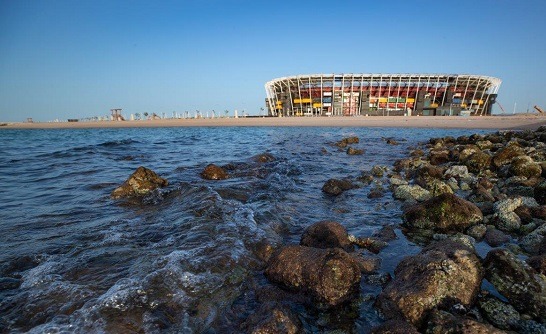DOHA (Qatar): When the first FIFA World Cup in the Middle East and Arab world takes place next year, the legacy the tournament leaves will be measured in many forms.
The first fully dismountable stadium in FIFA World Cup history has set a new benchmark.
Among the many endeavours the Supreme Committee for Delivery & Legacy (SC) has established in the build-up to Qatar 2022, innovations in stadium building and design have been a particular source of pride, whether it is the use of cooling technology in tournament venues or the commitment to sustainable practices in construction.
A symbol of that innovation and sustainability is coming to life, if one looks out over the stunning Doha Corniche and West Bay skyline.
Ras Abu Aboud Stadium is not only an impressive sight to behold with its construction made of colourful shipping containers, modular steel frame and removable seats, it will be the first fully dismountable stadium in World Cup history – a benchmark that will set new standards in stadium development.
As part of our focus on sustainability this month, qatar2022.qa takes a closer look at the many features that make Ras Abu Aboud a pioneering project in tournament legacy planning.
Modular design
While the other seven Qatar 2022 venues have been built with permanent foundations, the vision for Ras Abu Aboud is a temporary structure that not only provides a world-class venue for football’s showpiece event, but an innovative blueprint in making new stadiums – and sporting mega-events – sustainable. This will be achieved in legacy mode when the venue’s building blocks are dismantled and repurposed for future sporting and non-sporting projects in Qatar and overseas.
The stadium’s clever modular design also means that fewer building materials are required in its construction. This keeps costs down and reduces the duration of construction. Elements such as the cooling system that is being installed in other Qatar 2022 venues will not be required at Ras Abu Aboud, thanks to its seaside location offering a natural cool breeze off the Gulf – all while providing an electric atmosphere for fans and players alike during match days.
Waterfront transformation
Situated near Doha’s port and opposite the stunning West Bay shoreline, stadium designer Fenwick Iribarren Architects’ vision was inspired by the city’s maritime history when it incorporated colourful prefabricated shipping containers into the design and build of Ras Abu Aboud. Even the installation of 974 containers in the venue serves as a symbol of Qatar, as the number represents the country’s international dialing code.
And yet, the building of the 40,000-capacity venue and the surrounding precinct is only the first phase of a plan to transform the waterfront site into a space that will be enjoyed by all. Following Qatar 2022, a public green space development will replace the stadium site, which is sure to become a popular gathering place for locals.
Inspiring new possibilities
A key legacy aspect of Ras Abu Aboud lies not only in the plans to re-use the stadium building blocks in new sport and non-sport projects, but how it shows organisers of future events what is possible with temporary venues that can be visually appealing, easily disassembled and cost-effective.
Ras Abu Aboud sets new benchmarks and offers an important guide to staging sporting competitions that are more sustainable and legacy-driven. More importantly, it opens the door for countries around the world to consider opportunities of hosting sporting events that were previously beyond their means of realising or achieving.
Making progress
Completion of Ras Abu Aboud is edging ever closer, with all containers delivered and installed, while the stadium’s steel structure has also been completed. Installation of the stadium seats is over 80% completed, as are the mechanical, engineering, plumbing and finishing works.
“With the stadium site nearing completion, we have been able to start on the work around the stadium precinct,” said Ras Abu Aboud Stadium Project Manager, Mohammed Al Atwaan. “We are delighted at the way this project has progressed and are excited to see the finished product when it is ready to host matches in the near future and during the World Cup.”











